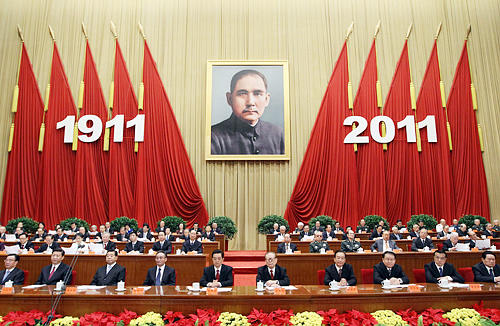|
 |
|
A GRAND CEREMONY: Top Chinese leaders attend a commemoration for the centenary of the 1911 Revolution in Beijing on October 9 (LAN HONGGUANG) |
This year marks the centenary of the 1911 Revolution that ended 2,000 years of imperial rule in China. The 1911 Revolution, which began on October 10, 1911, with an armed uprising in Wuchang, central China's Hubei Province, brought down the world's most long established monarchy and founded the first republican government in Asia.
To commemorate the centennial anniversary of the epoch-making event, a series of activities have been or are being held across the country.
On October 9, a grand ceremony was held at the Great Hall of the People in Beijing. President Hu Jintao and other top Chinese leaders attended. Hu gave a keynote speech.
Hu said that the 1911 Revolution was "a thoroughly modern, national and democratic revolution," which shook the world and ushered in unprecedented social changes in China.
"The 1911 Revolution overthrew the country's last feudal empire, the Qing Dynasty (1644-1911), and ended an absolute monarchy that had ruled China for thousands of years," Hu said.
"The revolution was also triggered by clashes between Chinese and Western values and subsequent attempts at reform by the ruling Qing court," said Zhang Ming, a professor at the School of International Studies of Renmin University of China.
The late 19th century was a period of great unrest in China. The country lurched from domestic disaster to humiliating foreign intervention, especially after the Opium War of 1840. In the face of this continuing national crisis, the Qing court made three attempts at reform.
The first attempt, known as the Self-Strengthening Movement (1861-95), initiated a series of changes aimed only at technological advancement.
Then, from 1895 to 1898, the reform movement led by Kang Youwei (1858-1927)and Liang Qichao (1873-1929) focused on political and institutional restructuring. Academic societies were formed and more liberal newspapers were published, while the reformists also translated Western works into Chinese in order to disseminate Western political theories and scientific knowledge.
After the defeat at the hands of the Eight-Power Allied Forces, consisting of troops of Britain, the United States, Germany, France, Russia, Japan, Italy and Austria, in 1900, Empress Dowager Cixi, the de facto ruler of China at that time, was finally persuaded to launch a series of political, economic, military and educational reforms. The purpose of the reforms was ultimately to keep the Qing court in power. However, two policies announced by the Qing court in May 1911—the formation of a cabinet dominated by royal notables in the run up to the constitutional monarchy and the nationalization of the railways—caused huge public resentment and drove many people to the revolutionary cause.
The cabinet comprised 13 officials, nine of whom were Manchus, including seven blue-blooded imperial clansmen. The seven controlled military, finance, personnel, law enforcement and internal affairs.
The exclusive nature of the appointment sent a powerful message to capable and ambitious officials of a humble origin—no matter how able you were, without the right lineage you did not belong in the ruling elite. With their hopes of upward mobility dashed, many frustrated would-be reformers were driven to the camp of revolutionaries.
At the same time, rising nationalism led people to demand that Empress Dowager Cixi return the railways to the people and revoke the mining rights that had been granted to foreigners. The operation of the railroads was particularly crucial to ordinary people's livelihoods. Merchants and members of the gentry, especially in southern provinces, were keen to form companies to run the railways, however the Qing court in May 1911 issued bonds to attract foreign investors and nationalized the country's railroads.
Outraged people in southwestern Sichuan Province formed the Railway Protection League, 200,000 people clashed with government forces in Chengdu, and the New Army of Hubei was mobilized to suppress the unrest, leaving the strategic city of Wuhan in a vulnerable position. The revolutionaries seized this opportunity and stormed the city's armory and the governor's office. The fire of revolution was ignited.
The Wuchang Uprising started a chain reaction in China. In less than two months, 14 out of the 18 provinces within China's borders had declared independence.
| 